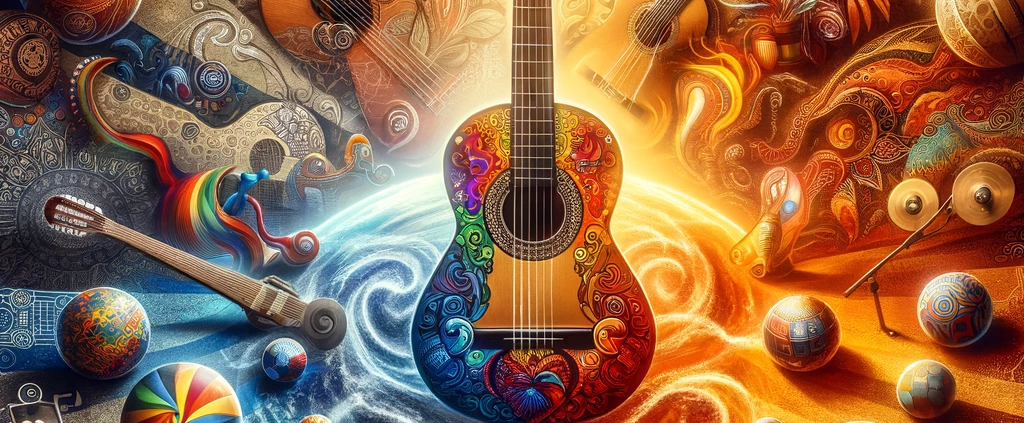What Significance Does the Guitar Have in the Music and Traditions of the Cultures It Comes From?
The guitar, with its rich tones and versatile nature, is one of the most beloved and widespread instruments across the globe. While the guitar originated in Europe, its influence has permeated nearly every corner of the world, adapting and enhancing the musical traditions of various cultures. Its adaptability, expressive qualities, and cultural symbolism have helped the guitar become a cornerstone of musical expression for centuries.
This blog explores the deep significance of the guitar in different cultural landscapes, examining its unique impact on global music traditions and the roles it plays beyond just an instrument of sound.
The Guitar as a Cultural Symbol
Before delving into individual regions, it is essential to recognize why the guitar has embedded itself in different cultures. Across societies, the guitar has represented:
- Storytelling – From blues ballads to flamenco’s emotive narratives, the guitar is often used to tell personal and cultural stories.
- Identity & Heritage – Genres like flamenco, samba, and mariachi are inseparable from their countries’ cultural identities.
- Innovation & Fusion – The guitar’s ability to blend with local styles has allowed new genres to emerge, such as highlife in Africa and bossa nova in Brazil.
- Community & Rituals – In many cultures, the guitar is integral to festivals, religious ceremonies, and social gatherings.
- Social & Political Movements – Protest music and revolutionary songs across different nations have often been driven by the guitar’s power to unite and inspire change.
- Spiritual & Religious Significance – In some cultures, the guitar plays a role in religious ceremonies and spiritual expression, offering a unique blend of harmony and devotion.
- Education and Oral Tradition – The guitar has been used as a pedagogical tool to pass down musical knowledge from generation to generation.
Now, let’s explore the unique significance of the guitar in various cultural traditions.
Spain
Flamenco, an art form deeply rooted in the Andalusian region of Spain, seamlessly intertwines guitar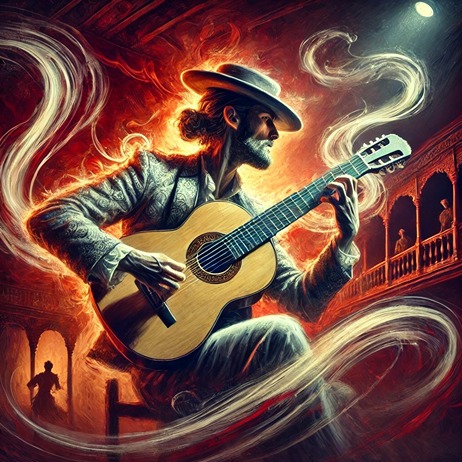
The Evolution of Flamenco Guitar
Initially, flamenco performances were dominated by vocalists, with minimal instrumental accompaniment—often just rhythmic hand claps or simple percussion. The guitar gradually emerged as a central element, evolving from basic rhythmic support to a sophisticated solo instrument. This transformation was propelled by guitarists who expanded the instrument’s expressive capabilities, integrating complex melodies and harmonies that now define modern flamenco.
Distinctive Techniques and Styles
Flamenco guitarists employ a range of specialized techniques that contribute to the genre’s unique sound:
- Rasgueado: Rapid strumming achieved by flicking the fingers outward, creating a vibrant, percussive effect.
- Picado: Executing swift, articulate single-note runs using alternating fingers, adding melodic intensity.
- Alzapúa: A thumb technique involving both upstrokes and downstrokes, producing a dynamic, rhythmic drive.
- Golpe: Tapping the guitar’s body to produce percussive accents, enhancing the rhythmic complexity.
These techniques, combined with the guitarist’s emotive expression, create the profound and stirring soundscape characteristic of flamenco.
Innovations by Paco de Lucía
One of the most influential figures in flamenco guitar history is Paco de Lucía. Born Francisco Gustavo Sánchez Gomez, he revolutionized the genre by infusing it with elements from jazz, classical, and other musical traditions. His virtuosic technique and innovative compositions expanded the flamenco repertoire and its global appeal. Notably, de Lucía introduced the cajón, a Peruvian percussion instrument, into flamenco ensembles, enriching their rhythmic texture. This adaptation has become so integral that many now consider the cajón a traditional flamenco instrument.
Cultural Significance and Global Influence
Flamenco guitar is more than a musical instrument; it embodies the soul of Spanish culture. Its emotive power conveys the joys, sorrows, and passions of the human experience. Festivals such as the Bienal de Flamenco in Seville celebrate this rich heritage, featuring performances that honor legends like Paco de Lucía. In the 2024 edition, renowned dancer Sara Baras dedicated an emotive opening speech to de Lucía, highlighting his enduring impact on the art form.
The flamenco guitar’s influence extends beyond Spain’s borders, inspiring musicians worldwide and integrating into various musical genres. Its distinctive sound continues to captivate audiences, ensuring that the legacy of flamenco remains vibrant and evolving.
Africa
The guitar’s journey into Africa began during the colonial era, introduced by European traders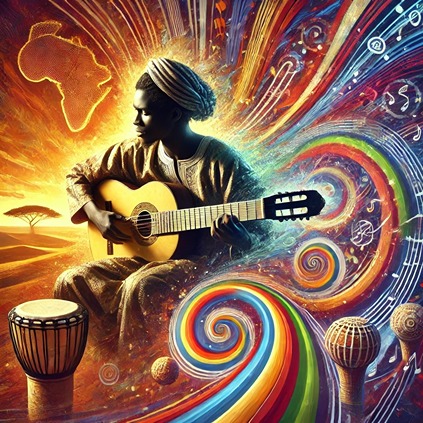
West Africa: Highlife and Palm-Wine Music
In West Africa, the guitar became central to genres like palm-wine and highlife. Palm-wine music originated in coastal areas, blending local melodies with influences from Portuguese sailors. The guitar provided a harmonic foundation, supporting storytelling lyrics and communal gatherings. As this style evolved, it laid the groundwork for highlife, which incorporated brass instruments and Western musical elements, leading to a more urban and dance-oriented sound. Guitarists in highlife bands often employed intricate fingerpicking techniques, mirroring traditional African stringed instruments.
Central Africa: Soukous and Rumba
In the Congo Basin, the guitar became synonymous with soukous and Congolese rumba. These genres emerged from a blend of African rhythms and Afro-Cuban music, introduced via records and radio broadcasts. Guitarists developed a distinctive style characterized by intricate, cascading riffs and interlocking melodies, creating a lively and danceable sound. Pioneering artists like Franco Luambo and Le Grand Kallé were instrumental in popularizing this guitar-centric music, which continues to influence contemporary African genres.
Mali: Desert Blues and Griot Traditions
In Mali, the guitar found a place within the rich tapestry of griot (traditional storyteller) culture. Musicians adapted the guitar to mirror the sounds of indigenous instruments like the ngoni and kora, leading to the development of the desert blues genre. Artists such as Ali Farka Touré blended traditional Malian melodies with blues structures, producing a hypnotic and soulful sound that resonates worldwide. The guitar in this context serves both as a melodic and rhythmic instrument, often employing modal tunings and repetitive motifs that evoke the vastness of the Sahara.
Guitar and Community in Africa
Music in Africa is inherently communal, playing a vital role in ceremonies, storytelling, and social cohesion. The guitar’s portability and versatility made it an ideal companion for various social settings, from intimate gatherings to large festivals. Its ability to accompany vocals and other instruments allowed it to seamlessly integrate into existing musical traditions, enhancing communal experiences and preserving cultural narratives.
The Influence of Traditional African Instruments
African guitar styles have been profoundly shaped by indigenous instruments. For instance, the kora, a 21-string harp-lute, and the ngoni, a plucked lute, have influenced guitarists to adopt alternate tunings and fingerpicking techniques that mimic the sounds of these traditional instruments. This cross-pollination has led to the development of unique guitar styles that reflect the tonalities and rhythms of African music, ensuring that the guitar, while foreign in origin, speaks the local musical language.
African Guitar Innovations
Contemporary African guitarists continue to push the instrument’s boundaries, incorporating modern effects, looping techniques, and blending genres. The evolution of Afrobeat, pioneered by artists like Fela Kuti, showcases the guitar’s role in creating complex, interlocking rhythms that drive the music forward. Similarly, the global rise of desert blues has brought attention to bands like Tinariwen, who fuse traditional Tuareg music with electric guitar riffs, creating a sound that is both ancient and contemporary. These innovations highlight the guitar’s adaptability and its central role in the ongoing evolution of African music.
In essence, the guitar in Africa is more than an instrument; it is a vessel of cultural expression, resilience, and innovation, continually bridging the past with the present.
The Guitar’s Role in Latin America
Latin American music is a vibrant tapestry of genres, each deeply rooted in the cultural and historical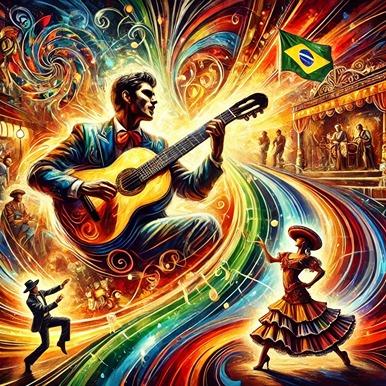
Tango and Folk Traditions
In Argentina, the guitar is integral to both tango and folk music. While the bandoneón often leads in tango ensembles, the guitar provides essential rhythmic and harmonic foundations. In Argentine folk music, genres like zamba and chacarera prominently feature the guitar, with intricate strumming patterns and emotive melodies that reflect the nation’s diverse cultural heritage.
Bossa Nova and Samba
Brazilian music showcases the guitar’s versatility, especially in genres like bossa nova and samba. Pioneers such as João Gilberto revolutionized bossa nova by introducing subtle, syncopated guitar rhythms that blend seamlessly with soft vocals, creating a laid-back yet sophisticated sound. In samba, the guitar often complements percussive elements, adding harmonic depth and driving the energetic dance rhythms that define the genre.
Mariachi and Ranchera
In Mexico, the guitar is central to mariachi and ranchera music. Mariachi ensembles traditionally include the vihuela, a small, high-pitched guitar, and the guitarrón, a large bass guitar. These instruments provide the rhythmic and harmonic backbone, supporting vibrant melodies and rich vocal harmonies that convey the passion and storytelling inherent in Mexican music.
The Charango
Beyond the standard guitar, Latin America is home to unique stringed instruments like the charango. Originating in the Andean regions of Bolivia and Peru, the charango is a small lute-like instrument traditionally made from the shell of an armadillo, though modern versions often use wood. With its bright, resonant sound, the charango is a staple in Andean folk music, accompanying songs and dances that celebrate indigenous heritage and social narratives. Its distinctive timbre adds a unique color to ensembles, enriching the musical landscape of the Andes.
Salsa
Salsa music, with its vibrant rhythms and infectious energy, has captivated audiences worldwide. While modern salsa predominantly features piano-driven arrangements, the guitar-like instrument known as the tres played a pivotal role in its early development. In recent years, the guitar has been regaining prominence in salsa, with several notable guitarists contributing to the genre’s evolution. In my band, Salsa Ithacana, the guitar is the driving force.
The Tres
The tres is a traditional Cuban stringed instrument characterized by three courses of two strings each, totaling six strings. It originated in the eastern regions of Cuba during the 19th century and became integral to musical genres such as changüí and son cubano, which are precursors to modern salsa. The tres provided the harmonic and rhythmic foundation in these early styles, with its distinctive sound shaping the music’s character. Notable tres players, or treseros, like Nené Manfugás were instrumental in popularizing the instrument in Santiago de Cuba and beyond. citeturn0search0
Evolution and Modern Incorporation of Guitar in Salsa
As salsa music evolved, especially with its growth in urban centers and international scenes, the piano often supplanted the tres, leading to a diminished role for guitar-like instruments in mainstream salsa ensembles. However, the guitar has never been entirely absent from the genre. In recent years, there has been a resurgence of interest in incorporating the guitar into salsa music, bringing a fresh and dynamic sound to the genre.
Several guitarists have made significant contributions to modern salsa, blending traditional elements with contemporary influences:
- Edgardo Miranda: Known for his work with Tito Puente and the Fort Apache Band, Miranda infuses salsa with jazz and fusion elements. His performances often feature ensembles comprising three percussionists, piano, bass, guitar, and flute, creating a rich tapestry of sound.
- Carlos Emilio: Featured on Irakere albums, Emilio brings a unique approach to salsa guitar, blending intricate melodies with Afro-Cuban rhythms.
- Luis Salinas: His album “Salinas” showcases a smooth, jazzy style, with arrangements that include guitar, bass, piano, drums, and conga, highlighting the guitar’s versatility in salsa music.
- Ivan Maraver: In “Fragmentos,” Maraver presents a jazzy interpretation of salsa, utilizing guitar, bass, drums, two percussionists, and flute to create a nuanced soundscape.
- Tom Guarna: Collaborating with Manuel Valera’s New Cuban Express, Guarna’s jazz-influenced guitar work complements ensembles featuring guitar, piano, bass, drums, conga, and saxophone, adding depth to modern salsa compositions.
- Greg Diamond: His work on “Conduit” features guitar, sax, bass, and drums, offering a mellow yet engaging take on salsa, even in the absence of traditional piano accompaniment.
- Steve Khan: With albums like “Backlog,” “Parting Shot,” and “Subtext,” Khan employs ensembles with bass, drums, timbales, bongos, and congas, integrating the guitar seamlessly into the salsa framework.
- Elmer Ferrer: A Cuban-Canadian guitarist, Ferrer’s album “Metropoli” exemplifies modern Latin fusion, blending traditional salsa elements with contemporary guitar techniques.
These artists exemplify the guitar’s renewed prominence in salsa music, enriching the genre with diverse textures and expanding its expressive potential.
The Guitar in Latin American Celebrations
Throughout Latin America, the guitar plays a pivotal role in various cultural celebrations and festivals. During Brazil’s Carnival, guitar-driven samba music fills the streets, encouraging communal dancing and festivity. In Mexico, the Día de los Muertos (Day of the Dead) features mariachi bands performing heartfelt songs that honor departed loved ones, with the guitar’s melodies resonating in both joyful and solemn commemorations. These events highlight the guitar’s ability to convey a wide range of emotions, making it indispensable in both public festivities and intimate gatherings.
The guitar’s profound influence across Latin America underscores its versatility and cultural significance. From the passionate strains of Argentine tango to the lively rhythms of Brazilian samba, and the soulful melodies of Mexican mariachi to the distinctive sounds of the Andean charango, the guitar remains a unifying thread in the rich and diverse tapestry of Latin American music.
The Middle East
The Middle East has a rich and diverse musical heritage, deeply rooted in modal melodies and intricate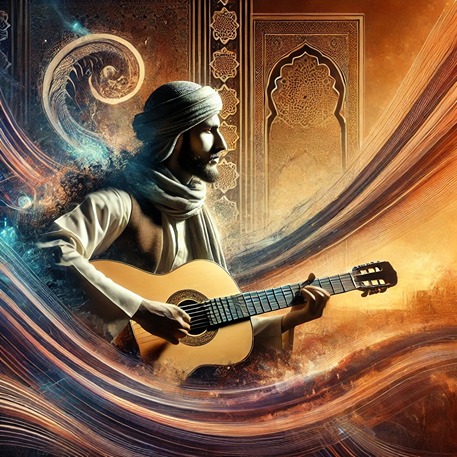
The Oud
The oud, often considered an ancestor of the guitar, dates back over 5,000 years to Mesopotamian and Egyptian civilizations. This instrument, known for its warm, resonant tone and highly expressive microtonal melodies, spread across the Islamic world and influenced the development of European lutes, which in turn evolved into the modern guitar. Unlike the guitar, the oud lacks frets, allowing for fluid glissandos and quarter-tone inflections, essential to Middle Eastern musical expression.
The Guitar’s Role in Middle Eastern Music
Despite being a Western instrument, the guitar has been embraced in various Middle Eastern genres, adapting to the microtonal scales and ornamentation that define the region’s music. In some styles, guitarists modify their playing technique to mimic the maqamat, the complex system of Arabic musical modes. Techniques such as bending notes, slides, and alternate tunings help bridge the gap between the Western tuning of the guitar and the fluid tonalities of Middle Eastern music.
Key ways in which the guitar is integrated into Middle Eastern music include:
- Classical Arabic and Turkish Music – Some guitarists adapt the maqam system, employing non-standard tunings to achieve quarter tones that are common in traditional compositions.
- Fusion with Rock and Jazz – Artists in the Middle East have incorporated electric guitars into their music, blending Arabic melodies with rock and jazz improvisation.
- Flamenco and Andalusian Influences – Due to historical ties between Spain and the Arab world, flamenco guitar has strong Middle Eastern influences, and contemporary fusion projects often highlight this shared musical lineage.
Guitar in Arabic Pop and Fusion Genres
The modern Arabic pop scene frequently incorporates the guitar, both acoustic and electric, into arrangements that mix traditional percussion and string instruments with Western harmonies. Artists such as Kadim Al Sahir (Iraq), Marcel Khalife (Lebanon), and Tamer Hosny (Egypt) have all embraced the guitar as a means of bridging old and new.
A new wave of musicians across the Middle East has also pushed boundaries by fusing the guitar with traditional styles. Le Trio Joubran, a Palestinian group composed of three oud-playing brothers, often collaborates with guitarists to create a soundscape that blends Arabic classical traditions with contemporary textures. Similarly, Iranian guitarist Shahab Tolouie blends Persian music with flamenco-style guitar, producing a hybrid sound that highlights the instrument’s adaptability.
In genres such as Oriental metal (e.g., bands like Myrath from Tunisia and Orphaned Land from Israel), the electric guitar takes a leading role, blending heavy metal riffs with Middle Eastern scales and instrumentation. These styles demonstrate how the guitar has not only been incorporated into traditional settings but also played a crucial role in the development of entirely new musical expressions.
India
While the sitar and veena have long been the defining stringed instruments of Indian classical music,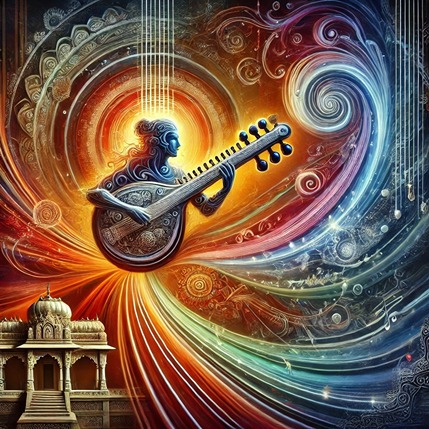
The Influence of Indian Classical Music on Guitar
Indian classical music is built on ragas (melodic frameworks) and talas (rhythmic cycles), which differ significantly from the harmonic-based structures common in Western music. Because standard fretted guitars are not designed for the gliding, fluid ornamentations that define Indian classical music, guitarists have developed new approaches to overcome this limitation.
Several adaptations have allowed the guitar to better express the nuances of Indian classical music:
- Slide Guitar Techniques – Since Indian classical instruments like the sitar and sarod produce continuous pitch slides (meend), guitarists use bottleneck slides or custom metal slides to recreate this effect.
- Alternative Tunings – Many Indian classical guitarists modify standard tunings to allow for drone strings, emulating the sustained resonance of traditional Indian instruments.
- Microtonal Expression – Guitarists often bend strings to achieve shruti (microtones), a key element in Indian classical performance.
The Mohan Veena
One of the most significant developments in adapting the guitar to Indian music is the Mohan Veena, a modified slide guitar designed by Grammy Award-winning artist Vishwa Mohan Bhatt. The Mohan Veena incorporates additional sympathetic strings, drone strings, and resonator elements, making it more suitable for performing ragas with the rich overtones characteristic of Hindustani classical music.
- The Mohan Veena bridges the gap between traditional Indian string instruments and Western guitars, allowing for deep sustain, expressive slides, and dynamic tonal variations.
- Vishwa Mohan Bhatt’s innovations have led to an entirely new school of Indian classical guitarists, inspiring musicians globally to explore the intersection of Indian music and slide guitar techniques.
The Guitar in Bollywood and Indian Popular Music
Beyond classical music, the guitar has become a defining instrument in Bollywood soundtracks and Indian pop music. Since the early days of Hindi cinema, composers have fused Western rock, jazz, and orchestral elements with Indian melodies and rhythms, with the guitar playing a crucial role in this synthesis.
- In the 1960s and 70s, Bollywood soundtracks began incorporating electric and acoustic guitars, often influenced by rock ‘n’ roll, Latin rhythms, and jazz harmonies.
- Iconic Bollywood composers like R.D. Burman and A.R. Rahman have used the guitar to add contemporary textures to traditional Indian music, blending elements of funk, blues, and electronic music.
- In modern Indian rock and indie music, the guitar is central to the sound of artists such as Parikrama, Indian Ocean, and Blackstratblues, who blend Indian folk music with Western rock and blues influences.
The Rising Global Influence of Indian Guitar Styles
As Indian music continues to influence global genres, many Western musicians have incorporated Indian-style slide guitar and raga improvisation into their playing. Renowned guitarists like Derek Trucks and John McLaughlin have drawn inspiration from Indian classical music, further demonstrating the guitar’s ability to transcend cultural boundaries.
Indian guitarists are also leading the way in fusion music, combining Carnatic and Hindustani elements with jazz, blues, and metal. Guitarists like Prasanna (Carnatic fusion) and Baiju Dharmajan (Indian classical-infused rock) exemplify this new wave of musicians who push the boundaries of the instrument.
The United States
In the United States, the guitar has been instrumental in shaping the nation’s musical landscape,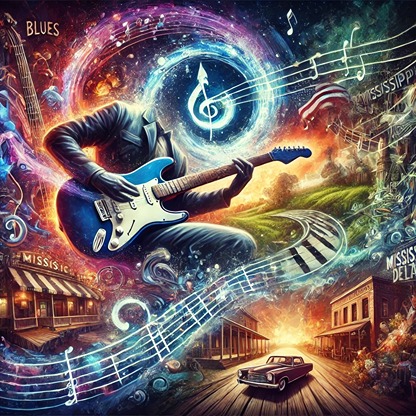
Blues
The guitar’s role in blues music is foundational. Early blues musicians transformed the guitar into an instrument of profound emotional expression. Techniques like the bottleneck slide and bent notes became hallmarks of the genre, allowing artists to convey deep feelings of pain, joy, and resilience. The guitar served as a medium for storytelling, with pioneers such as Robert Johnson and Muddy Waters laying the groundwork for future musicians. Their innovative styles not only defined the blues but also heavily influenced the development of rock ‘n’ roll.
Rock ‘n’ Roll
The advent of the electric guitar revolutionized rock ‘n’ roll, propelling it to the forefront of American culture. Artists like Chuck Berry and Elvis Presley harnessed the amplified power of the electric guitar to create energetic, rebellious sounds that resonated with the youth of the 1950s and beyond. Chuck Berry, often hailed as a pioneer of rock music, refined and developed the major elements that made rock ‘n’ roll distinctive, focusing on teen life and introducing guitar solos and showmanship that became a major influence on subsequent rock music. The electric guitar’s ability to produce louder and more dynamic sounds made it central to rock’s explosive rise in popularity. This era also saw the emergence of guitar heroes who expanded the instrument’s expressive range, incorporating feedback, distortion, and innovative playing techniques that continue to inspire musicians today.
Jazz
In jazz, the guitar evolved from a rhythm accompaniment to a lead instrument capable of intricate solos and complex harmonies. Pioneering guitarists such as Wes Montgomery and Django Reinhardt pushed the boundaries of the instrument, incorporating sophisticated chord progressions and improvisational techniques. Their contributions elevated the guitar’s status within jazz ensembles, showcasing its versatility and depth. The guitar became a voice for creative expression, blending seamlessly with other instruments while also standing out with distinctive solos.
Country Music
The guitar has been central to the development of country music, providing both rhythmic support and melodic leads. Maybelle Carter of The Carter Family pioneered a style known as the “Carter Scratch,” where she played melody lines on the bass strings while maintaining rhythm with the treble strings. This technique transformed the guitar into a lead instrument in country music and influenced countless artists across various genres. The portability and accessibility of the guitar made it a favored instrument among country musicians, serving as a companion for storytelling and personal expression.
The Guitar’s Enduring Legacy in American Music
Throughout the 20th century and into the present day, the guitar has remained a symbol of musical innovation and cultural expression in the United States. Its adaptability has allowed it to transcend genres, influencing the evolution of music and reflecting the diverse experiences of American life. From the soulful blues of the Mississippi Delta to the electrifying solos of rock arenas, the guitar continues to be an instrument that embodies the spirit of American music.
The Universal Language of the Guitar
Across continents, the guitar serves as more than an instrument—it is a cultural bridge, a storyteller, and a symbol of identity. From Spain’s flamenco passion to Africa’s rhythmic innovation, from America’s blues rebellion to India’s classical fusion, the guitar continues to evolve while preserving the deep traditions of the cultures it touches.
At Guitar Lessons Ithaca, we celebrate the guitar’s rich history and cultural significance. Our lessons embrace a wide range of styles, allowing students to explore the world through this incredible instrument.
—
At Guitar Lessons Ithaca, we celebrate the guitar’s rich history and its ability to unite diverse cultures through music. Our lessons embrace a wide range of styles and traditions, offering students the opportunity to explore the world through this incredible instrument.
Set up a free trial lesson, available both online and in-person, by filling out this form, and we’ll get back to you within 24 hours.

